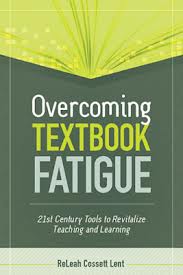Getting Past the Textbook
Overcoming Textbook Fatigue: 21st Century Tools to Revitalize Teaching and Learning
by ReLeah Cossett Lent
(ASCD, 2012 – Learn more)
I enjoy teaching, sharing and following the interests of students in and out of the classroom — experiencing the rapidly changing world of technology right along with them. But when a student tells me, “Mrs. Shaver, this book is boring,” and then when asked why, she proceeds to explain that it’s about old stuff that happened a long time ago…well, it gives me pause.
I liked the book she’s reading because the setting is in the 60’s and I grew up then. But she has no connection whatsoever with that decade. I have to stop and think, especially when the whole class nods in agreement with her. How do I make a book involving a 7th grader living five decades ago relevant to 7th graders in 2013 – middle school students who don’t know the name Walter Cronkite or know about transistor radios, but who have cell phones, video games and Internet?

Each year the challenge is greater than the last. Attention spans continue to get shorter. Sitting still in the classroom has become even more difficult. Technology distractions abound and are here to stay. Teachers like myself –using methods which perhaps once worked with students reading classroom textbooks, non-fiction and literature — face the decision to adapt traditional formats to modern technology and new engagement strategies and to offer content that will earn and hold student attention.
Overcoming Textbook Fatigue: 21st Century Tools to Revitalize Teaching and Learning is just the book to benefit teachers who feel the urgency to create more relevant lessons and revitalize classrooms for today’s students.
What’s in the book
Basing her information upon research, classroom experiences, and strategies proven to work, ReLeah Cossett Lent has written the text in a conversational, informative style, scaffolding the contents into eight chapters addressing specific areas of content. She begins with learning and engagement in Chapter One, followed by background knowledge, vocabulary, reading and writing to learn, learning assessment, and how to create and use text sets. Lent finishes with a chapter designed to help teachers and schools make the difficult transition to revitalized teaching.
Each chapter in Overcoming Textbook Fatigue is full of useful examples, strategies, advice, and techniques to use in instruction. The author stresses the importance of engagement in learning, citing studies indicating how engagement in the classroom improves student outcomes, making it a critical component of good teaching today. Students engaged in the classroom have control, choice, self-direction, and hence, they take ownership of their own learning.
By promoting social interaction, facilitating collaborative learning, and creating a sense of community, Lent says, teachers can recast students as problem solvers who need to seek out information in order to find solutions. Too often we become reliant upon textbooks and then feel the need to cover all the material. It is our responsibility as teachers, she says, to target student interests and create a culture of curiosity — to establish a learning environment where students are using the textbook as a resource rather than the sole basis of the class curriculum. (Lent also stresses the value of creating connections with other teachers of grade level or content, interdisciplinary teams or co-teachers to create a network to build on teaching ideas.)
Background knowledge, vocabulary and reading/writing strategies
Other chapters examine the importance of students’ background knowledge, which is crucial in unlocking meaning. Without background knowledge, texts are difficult to understand and “boring.” Ideas for building and assessing background knowledge include using prediction guides, carousel walks, free discussions, textbook scavenger hunts, picture books, virtual field trips, etc.
Suggested vocabulary strategies include creating tiers of unfamiliar textbook words based on difficulty and familiarity, using the Frayer model, illustrating words, including examples and figures to help in understanding, etc.
In the chapter on reading, ReLeah Cossett Lent emphasizes the need to find a reading strategy to fit the subject being taught, the importance of note taking, the value of discussion and writing, and the need to include differentiating texts.
Lent emphasizes that writing to learn means more than answering textbook chapter questions, and she provides recommendations for creating effective writing tasks, such as reflection assignments, interactive notebooks, graphic organizers, journals, blogging, and wikis. She stresses that assessing learning and checking for understanding go beyond the typical pop quiz or multiple choice test, with strategies such as evaluating learning logs, Think-Pair-Share classroom activities, “what do you think?” questions, conferences, oral responses, etc.
Creating your own text sets
In the final two chapters, Lent promotes the creation of text sets for the classroom — collections of resources about specific subjects that include online and print materials, audio and visual items — and she includes helpful suggestions for creating them.
Lent also describes what classroom engagement looks like, sharing actual classroom settings and situations. We see what happens as teachers shift into coaching roles and students move toward becoming independent learners. With one final emphasis on making this transition, the author underscores her belief that it is not a choice, but our obligation, to give students what they need to succeed. We have to approach our teaching with a different mindset. It’s not optional.
This is an excellent resource for all subject area teachers and for all levels. The author succeeds in presenting a wide variety of useful strategies to implement in the classroom with advice in using the Common Core Standards. She provides examples we can follow and points us to websites, resource lists, and ideas for guided book group discussion.
All in all, it’s not only a useful but an exciting book.
Textbook fatigue then and now
I can still remember the thrill and excitement of my first day in 7th grade. Our social studies teacher passed out brand new textbooks! The paper was slick and clean, the edges even. No bent, torn or crinkled pages. There were brightly colored pictures throughout, with an amazing set of maps right in the middle, made up of transparent overlays depicting the growth and development of the United States. How exciting!
Or so I thought, until we had to sit down and actually read the book, discuss and answer chapter questions, and take chapter tests. Over and over again. I thought we’d never get to the end. (And I don’t think we did!) How different my junior high social studies experience would have been if teachers then had been able to utilize even a few of the strategies presented by ReLeah Cosset Lent.
Today, we have the technology and the know-how to overcome textbook fatigue. And this very useful and exciting book shows the way.
Read another review of Overcoming Textbook Fatigue
Susan Shaver is a certified K-12 Library Media Specialist and teaches 7th Grade Reading and 7th & 8th Grade General Music in the Hemingford, Nebraska, Public Schools.































